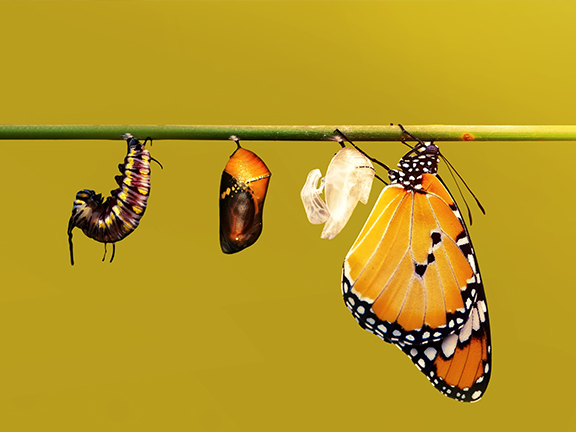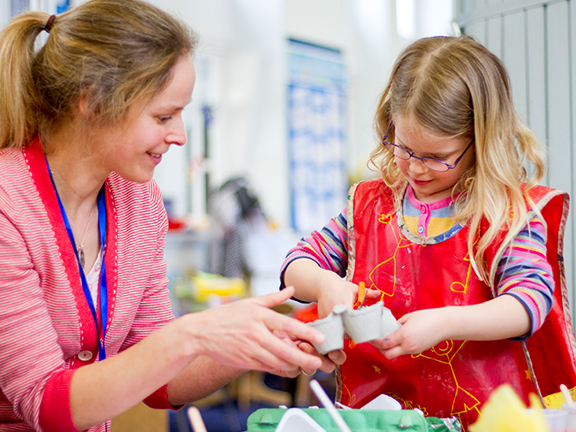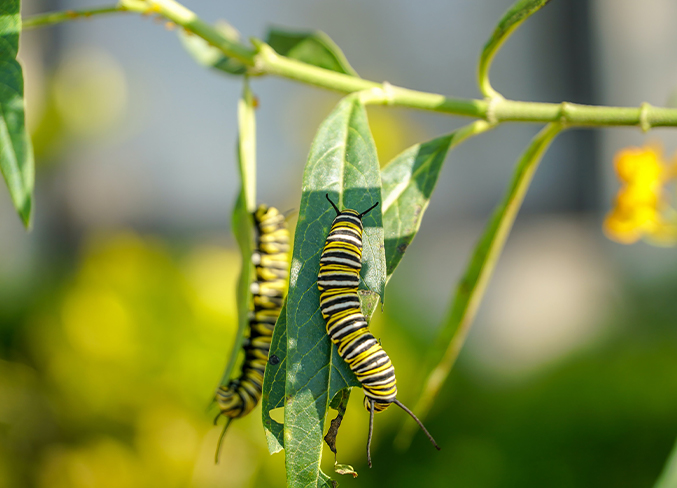Egg Carton Caterpillar
About the Activity
Caterpillars may look like simple insects, but they live a very fascinating life. They start their life as squirmy larvae, change into a chrysalis or cocoon, and then transform into a moth or butterfly. In this activity, kids will create their own caterpillar and learn facts about the insect’s life cycle.

Materials
These simple art supplies are all you’ll need to create your caterpillar:
Egg carton (the cardboard/paper kind will work better than foam or plastic)
Scissors
Paint
Paint brush
2 pipe cleaners
Black permanent marker
Two small googly eyes (Optional)
Glue (Optional)
Activity Steps
Let’s create our own colorful caterpillar.
First, you will need to cut your egg carton. Make sure to have an adult’s permission and supervision while using the scissors. You will only need one section of the egg carton for this exercise, so start by cutting off a single row.

 Did you know?
Did you know?Not all caterpillars are created equal. Some will grow to spin a silk cocoon and turn into a moth, while others will shed their skin to reveal a chrysalis before transforming into a butterfly.
Now, it’s time to get creative by painting the egg carton. Green and black are colors seen in different types of caterpillars, but since this is your own caterpillar creation, you can use as many colors and patterns as you like.
 Did you know?
Did you know?While a moth or butterfly is not necessarily reminiscent of its younger caterpillar selve, it can be fun to guess how a caterpillar will turn out once its metamorphosis is complete.
After you’re finished painting your caterpillar, allow 15-20 minutes for the paint to dry before moving to the next step.
 Did you know?
Did you know?Have you ever seen a caterpillar munching on a plant? As it eats the caterpillar grows and becomes too big for its own skin. Eventually it will have to shed or molt the old skin.
It’s time to insert the antennas on your caterpillar. Poke two holes with a tack or pen at the top of the first egg cartridge. You may want to ask an adult for help. Now that you have two holes at the top of the carton, thread one pipe cleaner through each hole and then tie the two pipe cleaners together on the inside of the carton. If you want, you could twirl each pipe cleaner around a pen to make them spiral.
Finally, glue your googly eyes to the side of the caterpillar’s head. If you don’t have googly eyes, use a marker to draw them on.
 Did you know?
Did you know?Butterflies and moths are holometabolous, meaning that they undergo a complete metamorphosis from egg to caterpillar and from chrysalis to adult.
Test Your Knowledge
See how much you learned about caterpillars.
Reflection Questions
Questions for your kids and teens.
What do you think is happening to a caterpillar while it’s in the cocoon or chrysalis?
Do you think you could spot the difference between a cocoon or chrysalis?
Do you think moths and butterflies have differences other than the type of structure they use to transform?
Investigate and Explore

Take what you’ve learned to the next level to learn more and explore the possibilities.
Whether a caterpillar transforms into a butterfly or moth, it will see four stages of life- egg, larva, pupa, and adult. A mother moth or butterfly typically lays eggs on a plant, which will later serve as food for the offspring. Over time, a caterpillar (known as the larvae) will hatch from the egg. The caterpillar’s first meal is it’s own egg shell, and after that it will eat plants. Once the caterpillar is ready, it will make a transformation into the third stage of life – the pupal stage. During this time, the caterpillar will spin itself into a cocoon or chrysalis to transform into its final form. When the time is right, the butterfly or moth will emerge from the cocoon or chrysalis, dry their wings and fly.




